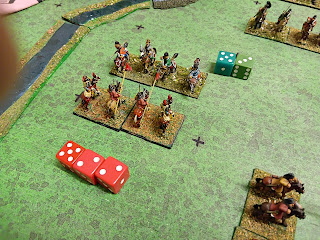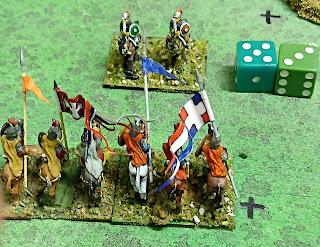
So far into the action, both fleets had taken serious damage. On the Azurian side, Amiral Duperre had been sunk, along with a torpedo boat. Though all Hellenic vessels were still afloat, Georgios Averof and Hierax were in a near-sinking condition, the armoured cruiser barely under way, and the destroyer dead in the water. Psara was also badly damaged enough to force its withdrawal from the action, escorted by Hydra. Lemnos had also not long before this taken heavy damage from a torpedo hit. But...
... To reach safe haven they would have to pass by their respective adversaries. The action was not yet by any means over. 
Seeking once and for all to put Averof under, torpedo boats TB3 and TB4 set off in pursuit. This was a risky enterprise, Averof still having three of its four main guns in action, and all of its secondaries. The destroyer Leon was also escorting the battered cruiser northward. TB3 unable to launch its torpedo, the reliance was being heavily placed upon TB4 to complete the mission.
The risks were to prove too high. Both torpedo boats took heavy damage from incoming fire. TB4 had its torpedo launchers wrecked before it could fire off the projectiles, and their popgun armaments failed to score any hits. Their mission a failure, both torpedo boats turned away from their more powerful adversaries, and began to seek a way out of the battle.
Meanwhile, exchanges of gunfire continued between the surviving capital ships, with some damage being inflicted on both sides. Although crippled, with its speed reduced, Psara still had teeth and could use them with effect. The Hellenic battleships set a course to the northeast, whilst Hoche and Carnot fetched a wide circle to try and put some distance between themselves and their enemy before settling upon the opposite course.
So the action might have ended here, both sailing off out of the strait. However, Admiral Poliomyelitis was not yet prepared to let the matter rest. Ordered 'to engage the enemy more closely', Hydra closed the range towards Carnot. Both sides took heavy damage. Hydra having so far taken more hurt than had Carnot, was the sooner forced to break off the action. For its part, Carnot was better able to absorb the punishment, but apprehending the approach of Lemnos still adding its big guns to the carnage, was also interested in getting away.
At this point only Lemnos of the Hellenic fleet was in a condition to take the fight, if it chose, to the enemy. On the other hand, Hoche and Carnot, despite considerable damage, were still able to maintain their battle line and to give Lemnos a tougher fight than it would want. Hoche had taken so far only superficial damage from a couple of hits. The encounter with Hydra had inflicted more serious hurt upon Carnot, but not enough to keep it out of a fight with Lemnos if it came to that...

 Hoche and Carnot - the latter's speed unimpaired by the torpedo hit (5FP) just taken - slipped by Lemnos, the range between enemies widening rapidly as they sailed on opposite course. TB2 long having departed, it remained for the remaining two torpedo boats to thread their way by the Hellenic fleet to escape. TB4 didn't make it...
Hoche and Carnot - the latter's speed unimpaired by the torpedo hit (5FP) just taken - slipped by Lemnos, the range between enemies widening rapidly as they sailed on opposite course. TB2 long having departed, it remained for the remaining two torpedo boats to thread their way by the Hellenic fleet to escape. TB4 didn't make it...As expected, Athenae trumpeted its victory over the vaunted Azurian Mesogesean Fleet. It was hard to deny that the Hellenic Fleet had scored a significant tactical victory, and a strategic one, too. The failure of the Azurian 'show of strength' in favour of its Turcowaz ally was undeniable. A capital ship and two torpedo boats sunk against no loss the the Hellenes would be hard to explain away - which didn't stop the Lutetia Lucifer mentioning the fact, in large headlines. The damage to Azuria's most powerful vessel, and its early departure from the action, also drew notice.
But it was not all brimstone and treacle for the Azurians. Three of Hellenia's four capital ships would be in drydock for months - possibly years, given than country's lack of major naval repair facilities. Lemnos itself was in a battered state that would require weeks in port, at least. Azuria still had Hoche, which could repair and replenish at sea, and the two flatiron gunboats that Admiral Ganteaume had carefully kept out of the battle. Let the Athenae owl crow, thought the Admiral - no ornithologist, he - Azuria was still in a position to give seagoing support for the Settee Empire, and Hellenia barely in any position to hinder him.
For the record, here is an abridged summary of damage to the respective fleets
Azuria:
Amiral Duperre - 17/12SP damage (sunk)Charlemagne - 15/16SP (12 from torpedoes)
Carnot - 10/16SP (5 from torpedo)
Hoche - 2/14SP
TB1 - 7/5SP (sunk)
TB2 - 4/5SP
TB3 - 4/5SP
TB4 - 5/5SP (lost, sunk)
Hellenia:
Georgios Averof - 11/12SP damagePsara - 8/12SP (6 from torpedo)
Hydra - 10/12SP
Lemnos - 13/20SP (5 from torpedo)
Leon - 1/5SP
Panthir - 3/5SP
Aetos - 4/5SP
Hierax - 2/5SP
The Hellenic destroyers surely bore charmed lives in this action!
A couple of post action points to mention:
- The effect of the torpedoes was devastating in this battle: every roll for effect being a 5 or a 6, the latter predominating. But that gives rise to the question: suppose the 'effects rolls' been 1s and 2s instead. I am now inclined towards an alternative method of determining the effect of a torpedo strike: adding the other two green dice. The minimum damage would be 2SP, the maximum 12 (three 6s on the three dice), and the mean 7SP.
- But that in turn raises the question of whether torpedo hits are too easy to obtain. Scoring at least one 6 with 3 dice is less than a 50-50 proposition - a little over 42% - but still seems a bit high. In this last action, both sides were fairly lucky with their torpedo attacks, especially the Hellenes. I'd probably leave it as is, simply because the torpedo boats and destroyers are under-represented compared with their historical naval antecedents.
- Questions remain as to whether a torpedo may be launched in each of successive turns from the same vessel whilst projectiles remain and launchers remain serviceable. I find it difficult to determine the arrangement of torpedo launchers upon these vessels, and whether torpedoes may be launched (leaving aside spar torpedoes) forward or in broadside. As a convention, I am leaning towards the following:
- If there is an odd number of launchers, ONE may be launched forward.
- All other torpedoes are launched abeam.
- Exception: Romanian torpedo boats have twin tubes firing forward only.
- All torpedo carrying craft have limited numbers of projectiles: one per launcher only. This number is given in my table of ship 'stats'. - I discover I had forgotten the effects of waterline hits upon target vessels. That had a considerable effect on the battle: as fought Georgios Averof would have gone under shortly after the rest of the fleet turned up. I'm not going to worry overmuch about that, but methinks a hardcopy printout of this schematic might be worth keeping by!
Well, so much for my overture to the upcoming - I'm not yet sure how soon that will be - Little Great War...


































































